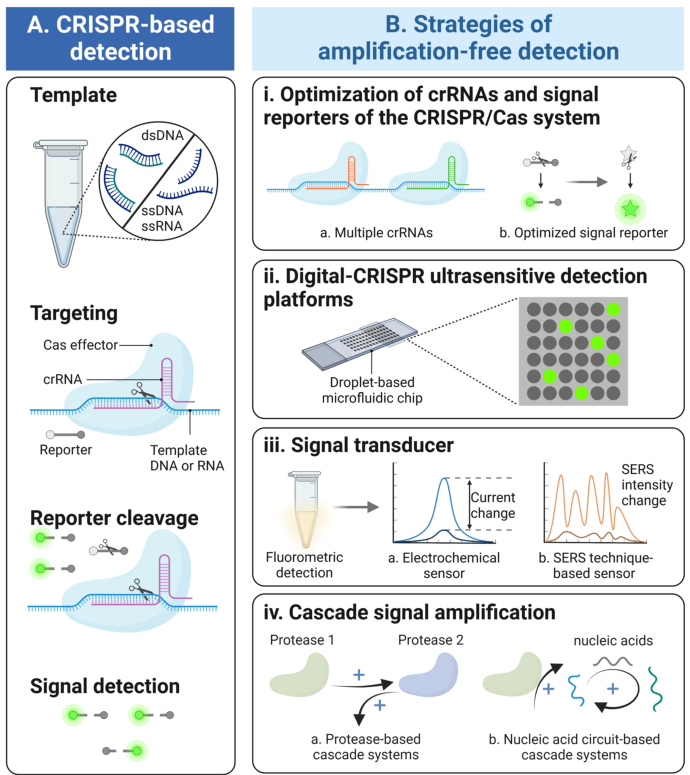
Schematic overview of target amplification-free CRISPR/Cas-based detection
基于CRISPR/CAS的无目标放大检测示意图概述
主讲人:黄义宝
Chem Soc Rev 丨Cite this: Chem. Soc. Rev., 2023,52, 361丨Received 15th August 2022丨DOI: 10.1039/d2cs00594h

Abstract:
Rapid and accurate molecular diagnosis is a prerequisite for precision medicine, food safety, and environmental monitoring. The clustered regularly interspaced short palindromic repeats (CRISPR)/ CRISPR-associated (Cas)-based detection, as a cutting-edged technique, has become an immensely effective tool for molecular diagnosis because of its outstanding advantages including attomolar level sensitivity, sequence-targeted single-base specificity, and rapid turnover time. However, the CRISPR/ Cas-based detection methods typically require a pre-amplification step to elevate the concentration of the analyte, which may produce non-specific amplicons, prolong the detection time, and raise the risk of carryover contamination. Hence, various strategies for target amplification-free CRISPR/Cas-based detection have been developed, aiming to minimize the sensitivity loss due to lack of pre-amplification, enable detection for non-nucleic acid targets, and facilitate integration in portable devices. In this review, the current status and challenges of target amplification-free CRISPR/Cas-based detection are first summarized, followed by highlighting the four main strategies to promote the performance of target amplification-free CRISPR/Cas-based technology. Furthermore, we discuss future perspectives that will contribute to developing more efficient amplification-free CRISPR/Cas detection systems.
摘要:
快速准确的分子诊断是精准医学、食品安全和环境监测的前提。基于簇状规则间隔短回文重复序列(CRISPR)/CRISPR相关短回文重复序列(CAS)的检测作为一种前沿技术,由于其具有全分子水平的敏感性、序列靶向的单碱基特异性和快速的周转时间等突出优点,已成为分子诊断的一种非常有效的工具。然而,基于CRISPR/CAS的检测方法通常需要预扩增步骤来提高分析物的浓度,这可能会产生非特异性扩增,延长检测时间,并增加残留污染的风险。因此,各种基于CRISPR/CAS的无靶扩增检测策略被开发出来,旨在最小化由于缺乏预扩增而造成的灵敏度损失,使非核酸靶标能够检测,并便于在便携式设备中集成。本文首先总结了无靶扩增CRISPR/CAS检测技术的现状和面临的挑战,然后重点介绍了提高无靶扩增CRISPR/CAS技术性能的四种主要策略。此外,我们讨论了未来的前景,这将有助于开发更有效的无扩增CRISPR/CAS检测系统。

